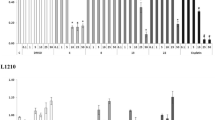Summary
4-Hydroxyproline di- and tri-peptides and N-cbz-hydroxypropylglycinamides were observed to be potent cytotoxic agents against the growth of suspended single cells, L-1210, Tmolt3, and HeLa-S3. The agents were not as potent against the growth of cultured solid tumor cells. Selected derivatives were investigated for their mode of action in Tmolt3 leukemia cells. The compounds selectively inhibited DNA synthesis at 50 and 100smM. The target site of action of the agents appeared to be the purinede novo pathway with marked inhibition of the activities of the two regulatory enzymes of the pathway, i.e. PRPP amido-transferase and IMP dehydrogenase. d[NTP] pools were reduced by the agents consistent with their overall reduction of DNA synthesis. Other marginally inhibited targets of the agents were r-RNA polymerase and TMP-kinase activities. The DNA molecule itself did not appear to be a target of these agents.
Similar content being viewed by others
References
Anderson KM, Mendelson IS, Guzik G (1975) Solubilized DNA-dependent nuclear RNA polymerases from the mammary glands of late-pregnant rats. Biochem Biophys Acta 383: 56–66
Archibald RM (1944) Determination of citrulline and allontoin and demonstration of citrulline in blood plasma. J Biol Chem 156: 121–142
Bagnara AS, Finch LR (1971) Quantitative extraction and estimation of intracellular nucleostide-triphosphate inEscherichia coli. Anal Biochem 45: 24–34
Becker JH, Lohr GW (1979) Inosine-5′-phosphate dehydrogenase activity in normal and leukemic blood cells. Klin Wochenschr 57: 1109–1115
Cadman E, Heimer R, Benz C (1981) The influence of methotrexate pretreatment on 5-flurouracil metabolism in L1210 cells. J Biol Chem 256: 1695–1704
Canne LE (1993) Synthesis of modified 4-hydroxproline peptides as multisubstrate analogue inhibitors of proly 4-hydroxylase. Ph.D. Thesis, University North Carolina, pp 1–113
Christopherson RI, Yu ML, Jones ME (1981) An overall radioassay for the first three reactions ofde novo pyrimidine synthesis. Anal Biochem 11: 240–249
Geran RJ, Greenberg NM, Macdonald MM, Schumacher AM, Abbott BJ (1972) Protocols for screening chemical agents and natural products against animal tumors and other biological systems. Cancer Chemother Reports 3: 9–24
Eichler DC, Fisher PA, Korn D (1977)Effect of calcium on the recovery distribution of DNA polymerase from cultured human cells. J Biol Chem 252: 4011–4014
Hall IH, Sajadi Z, Loeffler LJ (1978) Antineoplastic agents 111. Effects of dibromoethyl and vinyl esters of N-benzloxycarbonyl-L-phenylalanine on Ehrlich ascites tumor cell metabolism. J Pharm Sci 67: 1726–1731
Hall IH, Carlson GL, Abernathy GS, Piantadosi C (1974) Cycloalkanones IV. Antifertility agents. J Med Chem 17: 1253–1257
Hall IH, Hall ES, Miller MC III, Sood A, Spielvogel BF (1993) The effects of boron containing peptides on L1210 lymphoid leukemia metabolism. Amino Acids 4: 287–302
Ho YK, Hakala T, Zakrzewski SF (1971) 5-(1-Adamantyl) pyrimidines as inhibitors of folate metabolism. Cancer Res 32: 1023–1028
Hunting D, Henderson JF (1982) Determination of deoxyribonucleoside triphosphates using DNA polymerase: a critical evaluation. Can J Biochem 59: 723–727
Kalman SM, Duffield PH, Brzozwki TJ (1966) Purification and properties of a bacterial carbamyl phosphate synthetase. J Biol Chem 241: 1871–1877
Kampf A, Barfknecht RL, Schaffer PJ, Osaki S, Mertes MP (1976) Synthetic inhibitors ofEscherichia coli calf thymus and Ehrlich ascites tumor thymidylate synthetase. J Med Chem 19: 903–908
Koritz SB, Gohen PP (1954) Colorimetic determination of carbamyl amino acid and related compounds. J Biol Chem 209: 145–150
Leibovitz AL, Stinson JC, McComb WB III, McCoy CE, Mazur KC, Mabry ND (1976) Classification of human colorectal adenocarcinoma cell lines. Cancer Res 36: 4562–4569
Liao LL, Kupchan SM, Horwitz SB (1976) Mode of action of the antitumor compound bruceatin, an inhibitor of protein synthesis. Mol Pharmacol 12: 167–176
Loeffler LJ, Sajadi Z, Hall IH (1977a) Antineoplastic agents. 1. N-protected vinyl 1,2dihaloethyl and cyanomethyl esters of phenylalanine. J Med Chem 20: 1578–1584
Loeffler LJ, Sajadi Z, Hall IH (1977b) Antineoplastic agents. 2. Structure activity studies of N-protected vinyl, 1,2-dibromethyl, and cyanomethyl esters of several amino acids. J Med Chem 20:1584–1588
Lowry OH, Rosebrough J, Farr AL, Randall RJ (1951) Protein measurement with folin phenol reagent. J Biol Chem 193: 265–275
Maley F, Ochoa S (1958) Enzymatic phosphorylation of deoxycytidylic acid. J Biol Chem 233:1538–1543
Mamaril FP, Dobrjasky A, Green (1970) A rapid method for isolated of nuclei of Ehrlich ascites tumor cells. Cancer Res 30: 352–356
Moore EC, Hurlbert RB (1966) Regulation of mammalian deoxyribonucletide biosynthesis by nucleotide or activators and inhibitors. J Biol Chem 241: 4802–4809
Pera JF, Rawlings CJ, Shackleton J, Roberts JJ (1981) Quantitative aspects of the formation and loss of DNA interstrand crosslinks in Chinese hamster cells following treatment with cis-diaminodichloro-platinum(II) (cisplatin). Comparison and results from alkaline elution, DNA renaturation and DNA sedimentation studies. Biochem Biophys Acta 655: 152–166
Sawada H, Tatsumi K, Sadada M, Shirakawa S, Nakamura T, Wakisaka G (1974) Effects of neocarzinostatin on DNA synthesis in L1210 cells. Cancer Res 34: 3341–3346
Spassova MK, Russev GC, Goovinsky EV (1976) Some pyrazoles as inhibitors of purine biosynthesisde novo. Biochem Pharmacol 25: 923–924
Suzuki H, Nishimura T, Muto SK Tanaka N (1978)Mechanism of action of macromomycin: DNA strand scission, inhibition of DNA synthesis mitosis. J Antibacteriol 32: 875–883
Woynarowski JW, Beerman TA, Konopa J (1981) Introduction of deoxyribonucleic acid damage in HeLa S3 cells by cytotoxic and antitumor sesquiterpine lactones. Biochem Pharmacol 30: 3005–3007
Zhao Y, Hall IH, Oswald CB, Yokoi T, Lee KH (1987) Anti-malarial agents III. Mechanism of action of artesunate againstPlasmodium berghi infection. Chem Pharm Bull 35: 2052–2061
Author information
Authors and Affiliations
Rights and permissions
About this article
Cite this article
Hall, I.H., Chen, S.Y. Substituted 4-hydroxyproline di- and tri-peptides as cytotoxic agents. Amino Acids 16, 79–89 (1999). https://doi.org/10.1007/BF01318887
Received:
Accepted:
Issue Date:
DOI: https://doi.org/10.1007/BF01318887




